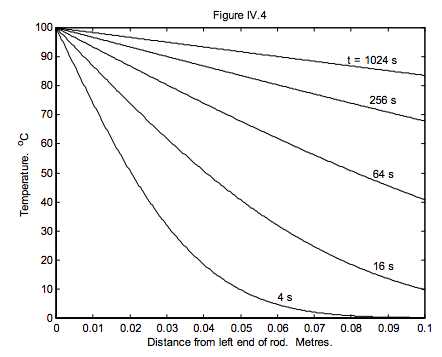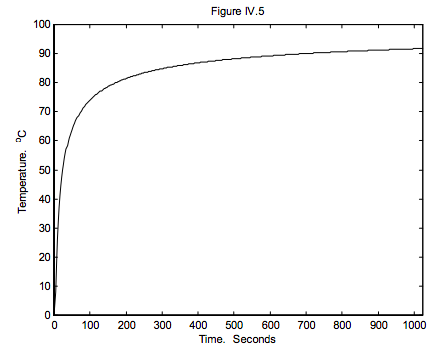4.5: A Solution of the Heat Conduction Equation
( \newcommand{\kernel}{\mathrm{null}\,}\)
Methods of solving the heat conduction equation are commonly given in courses on partial differential equations. Here we shall look at a simple one-dimensional example.
A long copper bar is initially at a uniform temperature of 0 oC. At time t = 0, the left hand end of it is heated to 100 oC. Draw graphs of temperature versus distance x from the hot end of the bar (up to x = 100 cm) at t = 4, 16, 64, 256 and 1024 seconds. Draw also a graph of temperature versus time at x = 5 cm, up to 1024 seconds. Assume no heat is lost from the sides of the bar.
Data for copper:
K = 400 W m−1 K−1
C = 395 J kg−1 K−1
ρ = 8900 kg m−3
whence
D = 1.137 × 10−4 m2 s−1
The equation to be solved is
D∂2T∂x2=∂T∂t
From the form of this equation, it is obvious (once it has been pointed out!) that a solution could be found in which T(x, t) is solely a function of x2/t, or, for that matter, x/t1/2. Thus, let
u=x/t1/2,
and you will see that equation 4.4.1 reduces to the second order total differential equation
Dd2Tdu2=−u2dTdu.
Let T' = dT/du, and it becomes even easier − a first order equation:
DdT′du=−12uT′.
Upon integration, we obtain
lnT′=−u24D+lnA,
where ln A is an integration constant, to be determined by the initial and boundary conditions. (What are the dimensions of A?)
That is,
T′=Aexp[−u2/(4D)].
We have to integrate again, with respect to u:
T=A∫exp[−u2/(4D)]du.
Now, T = 100 oC at x = 0 for any t > 0. That is, T = 100 for u = 0.
And T = 0 oC at t = 0 for any x > 0. That is, T = 0 for u = ∞.
Therefore
100−0=A∫0∞exp[−u2/(4D)]du.
The integral is slightly difficult though well known. I'll just state the answer here; it is −√πD. From this, we find that the integration constant is
A=−5284K m−1s1/2.
We now have
100−T(x, t)=A∫0xt−1/2exp[−u2/(4D)]du.
The error function erf(r) is defined by
erf(r)=2√π∫r0exp(−s2)ds,
so that equation 4.4.10 can be written
T(x, t)=100+A√πDerf(x2√Dt)=100[1−erf(x2√Dt)].
This function is easy to plot provided that your computer will give you the erf function. The solutions are shown in figures IV.4 and 5.




